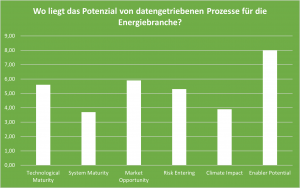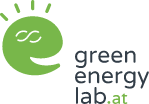Innovative data-driven processes for the energy sector
Getting a head start in the race to digitalize the energy sector through collaborative research and innovation.

© by Chris Yang via Unsplash
27 March 2023 – The gradual roll-out of smart meters, the constant decentralization of energy systems and the ever-increasing connectivity in smart spaces, smart cities and smart homes are causing data volumes and complexity in the energy sector to explode. At the same time, these challenges also offer great potential for the sector in Austria, which must be exploited. Existing digital roadmaps outline steps towards this goal and application-oriented research and innovation projects offer the ideal opportunity to innovate and accelerate these goals, namely the digital processes of the energy sector, by demonstrating and implementing concrete applications with high innovation potential in R&D projects. The Green Energy Lab innovation field “Data-driven processes” offers guidance on how to get closer to this goal through research and innovation.
Expert survey: Potential of data-driven processes for the energy sector
In the Green Energy Lab, we asked 22 selected national and international experts from our network, which is made up of Austrian forward-thinking energy supply companies, innovative tech developers and top research institutes that are jointly advancing the energy transition through research and innovation, about our exciting field of innovation “data-driven processes”.

Results of the survey of 22 national and international experts in the field of
research & innovation in the energy sector
As the illustration of the results of the survey shows, our experts see particularly great potential for data-driven processes for the energy sector in the “enabler potential”. The added value of using data-based methods for the areas of “Market Opportunity”, “Technological Maturity” and “Risk Entering” is also considered to be high, albeit somewhat lower. Less potential is expected for “Climate Impact” and “System Maturity”. Data-driven processes are therefore of particular interest to the energy sector due to this enabler potential, which can drive new technological developments, product innovations and digital business models faster.
The potential of data-driven processes for the energy sector
What are the fields of technology that are particularly relevant for data-driven processes in the energy sector and what added value can be created through application-oriented research and innovation? Green Energy Foresight analyzes thousands of signals, such as patents, publications, articles and highly innovative EU projects. Through our foresight activities – more on this in the latest news article – we were able to identify relevant technologies and their use in innovative data-driven processes in the energy sector and outline their added value. Projects from the Green Energy Lab project portfolio also clearly demonstrate how this potential is already being exploited today:
Real-time analysis: In conjunction with the new generation of real-time sensors in power plants, power grids or solar systems, operating data can be recorded and analyzed in real time. This enables preventive maintenance, where system downtimes can be predicted, automated real-time decisions can be made and changes in consumption and power generation can be responded to more quickly. Applications in the field of energy bidding are also relevant. Green Energy Lab example: The SmartU project is working on the development of a standardized hardware solution that converts smart meter data into a uniform format and makes it available via an interface.
Decentralized data storage and processing: Technologies such as edge and fog computing, IoT sensor technology and big data analyses enable greater resilience of energy systems and grids. Decentralized data processing reduces the impact of failures or delays in the network, as the data can still be processed locally. By processing data directly at the source, energy companies can reduce the amount of data that has to be transmitted over the network. This can save costs for transmission and storage capacities. Green Energy Lab example: In Blockchain Grid, an application was developed that allows users to autonomously allocate free grid resources among themselves. This was made possible by blockchain technology, which allows data records to be managed decentrally and end users to actively participate in the energy system as “prosumers”.
Increasing efficiency: IoT sensors can be used primarily in the building sector, by prosumers and in smart grid applications to collect real-time data on energy consumption and demand. This data can then be processed by big data analysis tools to gain insights into energy consumption and improve efficiency. Patterns in energy consumption can also be identified by using big data analysis tools in combination with AI and machine learning algorithms. On this basis, recommendations can be made for a more efficient use of energy. Green Energy Lab example: Spatial Energy Planning II deals with the efficient use of energy in spatial energy planning. An information system enables the efficient use of resources, taking into account the growing interdependencies between the electricity, heating and transport sectors.
Automation: Manual processes are replaced by automated workflows such as data cleansing, pre-processing and modeling. Energy companies can save time and resources while improving the accuracy and reliability of results. Complex decisions for the operational management of energy systems can be made automatically. By monitoring operating parameters, these algorithms can react automatically to faults and plan preventive maintenance work. Green Energy Lab example: AC/DC also brings automation to the mobility sector. Here, company fleets with electric vehicles are charged by automated charging robots and integrated into the energy grid using load, fleet and charging management systems.
Improved forecasting: AI and machine learning algorithms can analyze large amounts of data on historical energy use and generation to make predictions for future energy generation and demand, helping to optimize the electricity grid and better predict future energy prices. Green Energy Lab example: With the Open Data Platform, a central interface was created with the aim of deepening knowledge about interrelationships in the energy systems. The analysis of users’ consumption patterns and load flows forms the basis for the development of forecasting models in the project.
Innovation leadership through cooperative research
Integrated energy systems are therefore characterized by a high degree of complexity and innovations developed here require a holistic, transdisciplinary approach. The most innovative EU projects in this area combine the expertise of data scientists and technology developers from the ICT sector with the know-how of the energy sector. The above-mentioned potentials are already being investigated and tested together. Market opportunities are thus recognized and exploited at an early stage. Challenges such as the interoperability of different systems and protocols as well as the associated challenges in the area of cyber security are thus taken into account in the development of data-driven processes. More on this in the detailed summary from our Insight Talk “Cybersecurity4Energy“.
In summary, cooperative research and innovation projects offer an ideal opportunity for your organization to use the right know-how to design a suitable consortium around innovative project ideas and selected funding channels and thus decisively advance process digitization in an integrated energy system in your own company. With our many years of experience in implementing more than 50 research and innovation projects in the field of renewable energy, we are happy to support you in advancing your potential project. We combine visionary ideas from Green Energy Foresight with our expertise in project implementation and funding and an active network of more than 300 companies that are driving forward the energy transition through research and innovation activities.
Get in touch with us at karin.doegl@greenenergylab.at and launch national and EU-wide research and innovation projects with the aim of driving forward the digitalization of your processes and making the energy system fit for the future and sustainable.
Here you will find more information about the Green Energy Lab projects.
